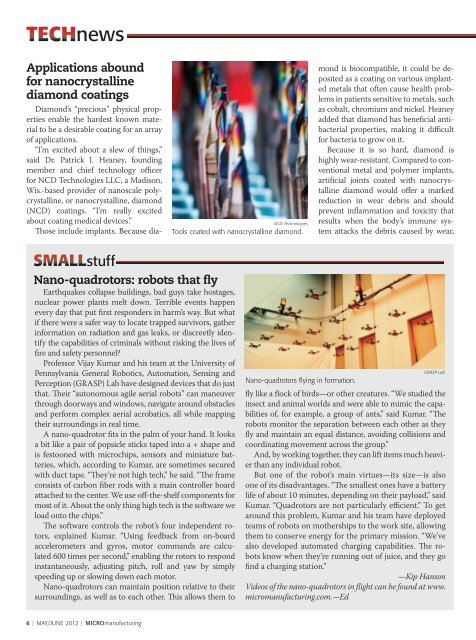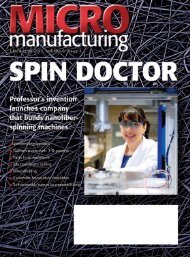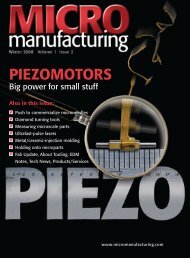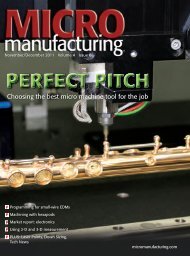to view as PDF - MICROmanufacturing
to view as PDF - MICROmanufacturing
to view as PDF - MICROmanufacturing
You also want an ePaper? Increase the reach of your titles
YUMPU automatically turns print PDFs into web optimized ePapers that Google loves.
TECHnews<br />
Applications abound<br />
for nanocrystalline<br />
diamond coatings<br />
Diamond’s “precious” physical properties<br />
enable the hardest known material<br />
<strong>to</strong> be a desirable coating for an array<br />
of applications.<br />
“I’m excited about a slew of things,”<br />
said Dr. Patrick J. Heaney, founding<br />
member and chief technology officer<br />
for NCD Technologies LLC, a Madison,<br />
Wis.-b<strong>as</strong>ed provider of nanoscale polycrystalline,<br />
or nanocrystalline, diamond<br />
(NCD) coatings. “I’m really excited<br />
about coating medical devices.”<br />
Those include implants. Because dia-<br />
SMALLstuff<br />
Nano-quadro<strong>to</strong>rs: robots that fly<br />
Earthquakes collapse buildings, bad guys take hostages,<br />
nuclear power plants melt down. Terrible events happen<br />
every day that put first responders in harm’s way. But what<br />
if there were a safer way <strong>to</strong> locate trapped survivors, gather<br />
information on radiation and g<strong>as</strong> leaks, or discreetly identify<br />
the capabilities of criminals without risking the lives of<br />
fire and safety personnel?<br />
Professor Vijay Kumar and his team at the University of<br />
Pennsylvania General Robotics, Au<strong>to</strong>mation, Sensing and<br />
Perception (GRASP) Lab have designed devices that do just<br />
that. Their “au<strong>to</strong>nomous agile aerial robots” can maneuver<br />
through doorways and windows, navigate around obstacles<br />
and perform complex aerial acrobatics, all while mapping<br />
their surroundings in real time.<br />
A nano-quadro<strong>to</strong>r fits in the palm of your hand. It looks<br />
a bit like a pair of popsicle sticks taped in<strong>to</strong> a + shape and<br />
is fes<strong>to</strong>oned with microchips, sensors and miniature batteries,<br />
which, according <strong>to</strong> Kumar, are sometimes secured<br />
with duct tape. “They’re not high tech,” he said. “The frame<br />
consists of carbon fiber rods with a main controller board<br />
attached <strong>to</strong> the center. We use off-the-shelf components for<br />
most of it. About the only thing high tech is the software we<br />
load on<strong>to</strong> the chips.”<br />
The software controls the robot’s four independent ro<strong>to</strong>rs,<br />
explained Kumar. “Using feedback from on-board<br />
accelerometers and gyros, mo<strong>to</strong>r commands are calculated<br />
600 times per second,” enabling the ro<strong>to</strong>rs <strong>to</strong> respond<br />
instantaneously, adjusting pitch, roll and yaw by simply<br />
speeding up or slowing down each mo<strong>to</strong>r.<br />
Nano-quadro<strong>to</strong>rs can maintain position relative <strong>to</strong> their<br />
surroundings, <strong>as</strong> well <strong>as</strong> <strong>to</strong> each other. This allows them <strong>to</strong><br />
6 | MAY/JUNE 2012 | <strong>MICROmanufacturing</strong><br />
NCD Technologies<br />
Tools coated with nanocrystalline diamond.<br />
mond is biocompatible, it could be deposited<br />
<strong>as</strong> a coating on various implanted<br />
metals that often cause health problems<br />
in patients sensitive <strong>to</strong> metals, such<br />
<strong>as</strong> cobalt, chromium and nickel. Heaney<br />
added that diamond h<strong>as</strong> beneficial antibacterial<br />
properties, making it difficult<br />
for bacteria <strong>to</strong> grow on it.<br />
Because it is so hard, diamond is<br />
highly wear-resistant. Compared <strong>to</strong> conventional<br />
metal and polymer implants,<br />
artificial joints coated with nanocrystalline<br />
diamond would offer a marked<br />
reduction in wear debris and should<br />
prevent inflammation and <strong>to</strong>xicity that<br />
results when the body’s immune system<br />
attacks the debris caused by wear,<br />
GRASP Lab<br />
Nano-quadro<strong>to</strong>rs flying in formation.<br />
fly like a flock of birds—or other creatures. “We studied the<br />
insect and animal worlds and were able <strong>to</strong> mimic the capabilities<br />
of, for example, a group of ants,” said Kumar. “The<br />
robots moni<strong>to</strong>r the separation between each other <strong>as</strong> they<br />
fly and maintain an equal distance, avoiding collisions and<br />
coordinating movement across the group.”<br />
And, by working <strong>to</strong>gether, they can lift items much heavier<br />
than any individual robot.<br />
But one of the robot’s main virtues—its size—is also<br />
one of its disadvantages. “The smallest ones have a battery<br />
life of about 10 minutes, depending on their payload,” said<br />
Kumar. “Quadro<strong>to</strong>rs are not particularly efficient.” To get<br />
around this problem, Kumar and his team have deployed<br />
teams of robots on motherships <strong>to</strong> the work site, allowing<br />
them <strong>to</strong> conserve energy for the primary mission. “We’ve<br />
also developed au<strong>to</strong>mated charging capabilities. The robots<br />
know when they’re running out of juice, and they go<br />
find a charging station.”<br />
—Kip Hanson<br />
Videos of the nano-quadro<strong>to</strong>rs in flight can be found at www.<br />
micromanufacturing.com.—Ed















